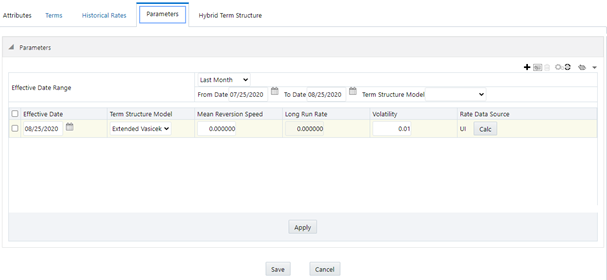5.2.2.2.1 Parameter Estimation
This section explains the procedure to calculate the estimated parameters.
Prerequisites
Installation of R and Oracle R Enterprise (ORE) is required to use the Term Structure Parameter Estimation functionality under Rate Management - Interest Rates, for computing term structure parameters.
For more information, see the OFS Advanced Analytical Applications Infrastructure Installation and Configuration Guide.
- Term point: Underlying historical rates must be available for a 30-Day or 1-Month term point.
- Minimum Number of historical rates: A total of at least 10 historical rates (observations) are required, on appropriate look-back dates.
- Lookback Dates: Historical rates must be available on
dates looking back from the Parameter's Effective Date (the End Date), in 30-day
intervals moving backward from End Date to Start Date, for a minimum of 10
intervals.
For example: If the first rate's Effective Date is 1 Jan. 2013, then the second rate's date must be 2 Dec. 2012 (1 Jan. 2013, 30 days = 2 Dec. 2012), and so on. If a rate is not found for the required date, the engine looks for a rate within the neighborhood of 5 days up or down (therefore a total range of 10 days), searching iteratively starting with Date -1, then Date +1, through Date +5, then Date -5. The next rate lookup would be 60 days before the End Date, and so on.
The minimum relative term for all lookbacks must be at least 300 Days (that is, to accommodate a minimum of ten 30-day intervals). Using the above logic, if a rate is not found for the lookup date (or date within the neighboring range), an error will be logged in FSI_PROCESS_ERRORS with ID_Number to identify the Interest Rate Code, and the parameter estimation Engine will exit.
Figure 5-8 Parameters Tab on Interest Rate Code window

To edit or recalculate the existing Parameters, enter the Effective Date Range filter.
- The following icons are available here:
- Add
- Delete
- Data Input Helper
- Refresh
- Excel Export or Import
- Default parameters for the Extended Vasicek Model are
displayed for one Effective Date (the System Date on which the Interest Rate Code
was created). You can edit these parameters or add new parameters using
Add. Use the Refresh to return to
existing Parameters.
Note:
Steps 3 and 4 are applicable only if you are Adding or Editing Parameters.To add or edit the parameters, use the Data Input Helper or Excel Import or Export. For more information, see the Excel Import or Export and Data Loader sections.
- Enter the Effective Date. Note that the Effective Date cannot be greater than the Current System Date.
- Select the Model from the Term Structure Model drop-down list. Effective Date and Term Structure Model combination must be unique within this IRC.
- The following term structure models are utilized in stochastic modeling of interest
rates in OFS FTP and OFS ALM:
- Extended Vasicek
- Ho and Lee
- Merton
- Vasicek
- The following parameters needed by the models:
Table 5-1 List of supported parameters for Models Term structure models in Interest Rate
Model Parameter 1 Parameter 2 Parameter 3 Extended Vasicek Volatility Mean Reversion Speed Ho and Lee Volatility Merton Volatility Vasicek Volatility Mean Reversion Speed Long Run Rate - Values for Long Run Rate and Volatility are in percentages.
For example, a Long Run Rate of 5% is displayed as 5.000. To maintain the integrity of data, Rate Management restricts the accepted input values. The valid range and the default setting for each parameter.
Table 5-2 Valid Range and Default Values of Interest Rate Parameters
Parameter Valid Range Default Value Volatility 0% to 500% 0.01 Mean reversion speed 0.00 to 500 0.0 Long run rate 0.00% to 500% 0.0 - The Rate Data Source indicates if you have directly entered Parameters through the UI. You can calculate the Parameters to display system-generated values.
- Select Calculate to view the Term Structures Parameter Estimation window.
- If you are directly entering the Parameters, then enter values appropriate to the Model, then click Apply else click Calculate.
- The End Date is auto-populated with the Effective Date. Enter the Relative Term with Multiplier to define the rate look-back period.
- The Term or Multiplier value must be at least 300 Days.
- The Start Date is automatically updated after entering a Relative Term.
- Click Calculate Number of Observations to confirm the number of rates found for appropriate dates within the Relative Term. If there are at least 10 observations, then the Estimate option will become active.
- Click Estimate to calculate the parameters and store them in the Historical Parameters table (FSI_IRC_TS_PARAM_HIST). A confirmation message is displayed. Click Ok. The calculation will complete and you will be directed back to the Parameters tab.
- Similar to the validation used for direct input from the UI, if any of the calculated parameters are outside of the valid range, the Engine displays an error message.
Delete parameters by selecting one or more rows and then clicking Delete. For more information on term structure models and stochastic processing, see the OFS Funds Transfer Pricing User Guide, OFS Asset Liability Management User Guide, and OFS Cash Flow Engine Reference Guide.